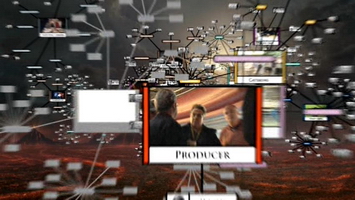
Arch
443/646: Architecture and Film
Fall 2005
The Web Project
 |
Arch
443/646: Architecture and Film The Web Project |
link
to the final web page -- a work in progress!!....
the architecture of zero gravity _ architecture and
film 2005 _ a web project |
The original Star Wars episide, "A New Hope", released in 1977, used the full range of filming technologies that were available at the time. Green screening combined with rear and front projection, limited special effects, live scale models that represented objects too large to physically build and move, site shooting as well as studio sets. George Lucas spent the next 15 to 20 years creating technologies that would see his dreams more fully and more believably realized. I believe that what was accomplished in cinematographic terms in the making of "The Revenge of the Sith", through the use of CGI technology, has taken the making of "space films", and indeed any film that wishes to use an imaginary environment, to a realm of realism in both vision and the accomodation of movement, that it is fairly safe to say that whatever a director or a producer may wish to happen in a film, can happen. Lack of technology can no longer be the reason to exclude just about anything from a film. This particular version of my film course has directed its content towards an appreciation for the role of "gravity" in both architecture and film. We have studied how filming and editing techniques and technologies have evolved to be able to create believable imaginary worlds. Instead of each student undertaking a site that is based upon a single film, each student will select a "word" or "topic" and be required to address the progression of that "piece" of the theme of the course, through all of the applicable films that we have viewed this term. Other films with which you are familiar and whose techniques or approaches can fortify the discussion, are also welcome to be included. I will place a CD in Musagetes with the 1000s of screen captures that I have created throughout the term to assist in populating your web sites. I will create the main page for the site. Each of your topics should include 1,500 words of text for undergrads, 3,500 words for masters students. Since this is a research project, be sure to include bibliographic references. The format of each section need not follow any uniform guidelines. This is to be a creative project to illustrate your proficiency in Dreamweaver. Just be sure to provide a link back to the main page that I will set up once I know which topics you intend to pursue. Feel free to use any of the musings that we have posted this term on our discussion pages to feed your site with ideas or information upon which to expand. That is why we did this... More later. I know you have lots to do between now and then, but you might want to be thinking.... Also remember that the main computer lab shuts down the last week of exams. But you can always download the Dreamweaver free 30 day trial to your home machine. http://www.macromedia.com/software/dreamweaver/ However, they are up to the next software version and I have not looked at it for differences from the one I demonstrated. Please have a look at the list below and
email me your 1st, 2nd and 3rd choice preferences at tboake@sympatico.ca The topics will be given out on a first requested basis. There are more
topics than students in the course. If you are hot to do something different
than I have listed, just email me and I will consider it. This list is
by no means exhaustive! |
| x |
last updated Sunday, December 18, 2005 6:17 PM
topics
|
who??
|
|
1 |
the atmosphere
|
|
2 |
acknowledgement of zero gravity in film
|
David Takacs |
3 |
representation
of exterior natural environments
|
|
4 |
representation of urban space environments |
Emily Maemura |
5 |
representation of interior environments
|
Mat Triebner |
6 |
personal space :: the "environment suit"
|
Allison Janes |
7 |
eating in space
|
Andrea Wong |
8 |
doors in space
|
Helen
Pallot |
9 |
development of "green screening" techniques
|
|
10 |
the use of scale models for space/vehicular craft
|
|
11 |
the use of scale models for exterior environments
|
|
12 |
music and these films
|
Nathan Rehorick |
13 |
the architectural "style" of our space
future
|
Dereck McCallum |
14 |
space: "reality" versus "fantasy"
|
B J Smith |
15 |
the role of science,
time and accuracy
|
|
16 |
communication and computers
|
Matt Storus |
17 |
filming advances due to computer technologies
|
|
18 |
unique inventions and their effect on filming (steadicam, moving cameras,
etc.)
|
|
19 |
the materiality of space construction |
Elfie Kalfakis |
20 |
geometry in the design of space architecture |
|
x |
updated
18-dec-05 6:17 PM